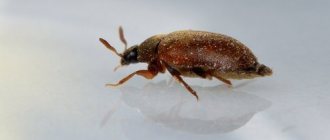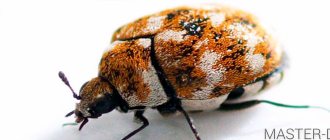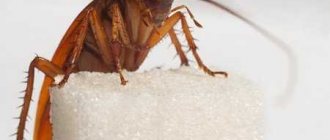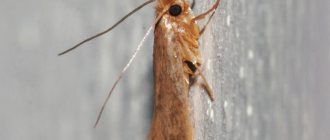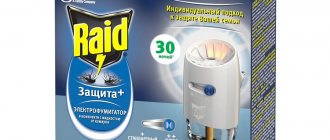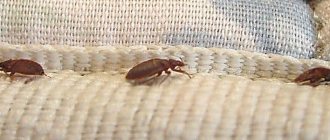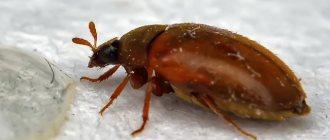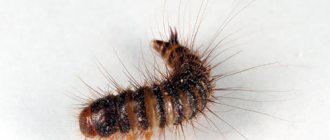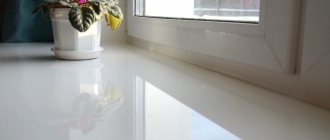There are several effective and fairly easy-to-implement ways to get rid of skin beetles in an apartment. In general, both adult carpet beetles and their larvae do not differ in any increased resistance to insecticides and die even when treated with relatively inexpensive preparations, but only in the case when these preparations manage to treat either the insects themselves or the surfaces on which they often crawl. And since neither skin beetles nor their larvae are particularly mobile, it turns out that the majority of these insects simply hide where they cannot be found and continue to quietly breed.
Adult skin beetle and last instar larva
In our experience, all people who turn to us for a service to remove skin beetles cannot cope with these insects simply because they do not find their main breeding sites. And we ourselves usually have to tinker with such pest control areas to find such places.
And in about half of the cases of such treatments, these places where skin beetles accumulate are, in principle, impossible to reach - the beetles and their larvae are located where you cannot get to either with your hands, much less with a spray bottle. In such cases, only professional equipment or mini-repairs can help.
But first things first.
Destruction of skin beetles in three steps
In the most general case, the destruction of skin beetles is carried out according to the following plan:
- All places where leather beetles hide, breed and feed are searched and opened. This is the most difficult stage, because due to their phenomenal omnivorous nature, these bugs with their larvae can safely exist, grow and reproduce almost anywhere.
- Places where insects accumulate are treated with insecticides.
- Additionally, with preparations with a long residual effect, places where either adult beetles or larvae were regularly encountered, but where they are not permanently present, are treated. Here the calculation is made on the fact that insects that are not in places of accumulation and that can survive the treatment can move along these surfaces. Having come into contact here with a drug with a long residual effect, the insects will die, albeit later than the main part poisoned directly.
Here in the photo, for example, beetles collected in the apartment after disinfestation:
With professional disinfestation, the third stage is not needed - in the second step, all surfaces and possible hiding places of skin beetles are sprayed so intensively that they all die. Even if some individuals survive such baiting, with the slightest subsequent movements they will end up on a layer of the drug, which will remain in those places where the owners of the apartment, even with thorough cleaning, will not be able to remove it - behind the baseboards, on the back walls of furniture, under floor covering. And all these surviving characters will die. Although, according to our observations, no surviving skin beetles remain indoors after proper treatment with professional products.
Let's now go through each point in order.
Tips and tricks
To get rid of parasites quickly and permanently, you should know a few small tricks:
- Carpet beetles do not like moisture. Therefore, the more often wet cleaning is done, the lower the risk of their occurrence.
- In summer, beetles are most active , and during this period there is the greatest likelihood that they can move in with you.
- Adult parasites fly around the house during the day and return to their shelter at night. Therefore, in order to discover their habitat, you can simply turn on the light bulb at night, to which they will flock.
- The larvae are always active, day and night, they do not need sleep.
- If the house is warm , small bugs will develop faster and in greater numbers. And if it’s the other way around, then it’s slower, but will cause more damage.
Search for places where skin beetles accumulate and hide in an apartment
This stage is the simplest technically, since it does not involve any complex actions, but it is also the most labor-intensive, since in order to find all the hideouts of skin beetles, you need to:
- Carefully inspect all food supplies. The most preferred food for skin beetles is grocery products, long-stored meat products (sausage, dried fish, semi-finished products), and dried fruits. Very often, accumulations of skin beetle larvae and a large number of the bugs themselves are found in closets, bedside tables and cupboards in the kitchen, as well as behind them, under them and near them. Remember, by the way, that skin beetle larvae quite easily gnaw through plastic bags and climb inside them or get out of them.
- Open and disassemble the sofa, remove mattresses from beds, disassemble bed frames. Very often, skin beetle larvae settle in leather sofas and gnaw their upholstery, or settle under mattresses and feed on the skin that peels off from sleeping people.
- Remove baseboards near beds and closets and inspect the spaces behind them. Microscopic organic particles often accumulate behind the baseboards, as well as the remains of the bodies of other insects - cockroaches, bedbugs, silverfish. All of them are eaten by both skin beetle larvae and beetles.
- If possible, you need to unscrew the edges of the linoleum or carpet on the floor, remove the trim on the frames of interior doors, look behind the peeling wallpaper - there may be leather beetles everywhere.
- If the house has various collections - herbariums, stuffed animals, butterfly exhibits in glass boxes - they all need to be examined. This is the main target for skin beetles, which are known as the scourge of zoological and botanical collections.
The main difficulty in such searches is that leather beetles themselves are not social or colonial insects; they do not need each other at all until they reach adulthood and therefore absolutely calmly crawl throughout the apartment and can be found alone in completely different places. Therefore, often quite complex manipulations with sofas, beds and closets end with the discovery of only 2-3 insects. And to find all the pests, you literally need to turn half the house upside down and dismantle it.
For example, they can sometimes be found in a slipper, where the larvae eat the cotton lining seasoned with the skin that peels off the feet:
However, the most attractive places for skin beetles attract the bulk of individuals living indoors, and here entire clusters of them are usually found, albeit very chaotic.
In addition, in some species of skin beetles, adult individuals are quite small and cannot always be seen from a distance of a meter and a half.
In our treatments, we most often find skin beetles in the following places:
- Leather sofas, including under the upholstery inside the filling.
- Gaps behind baseboards and under parquet.
- Closets.
- Shelves and cabinets on balconies.
- Spaces under cabinets.
Adult bugs very often accumulate on window sills, but usually individuals appear here that have flown from the street onto the balcony.
If any products contaminated with skin beetle larvae are found in the apartment, then it is advisable to throw these products away . Trying to remove insects from them and keep the same cereal, or vermicelli, is too difficult.
Our statistics
We must admit that we very rarely come across apartments with some kind of very strong infestation of skin beetles. In most cases, at most several dozen individuals live in one house or apartment, and in 14 years we have had 5-6 situations where we found hundreds of them in one dwelling. It’s just that even 30-40 leather beetles in a room multiply quite quickly, their beetles come across quite often, and the larvae, due to their high mobility, can be found in various parts of the apartment, which gives the impression that these insects are everywhere here.
Here, in the photo, the edges of the carpet are damaged by carpet beetle larvae
As a rule, if you manage to find 2-3 places where skin beetles accumulate in an apartment, you can consider this a success. The only thing left to do is to etch them here and leave the product in all similar places in the room. Still, there may also be single individuals huddling there, which either could not be noticed, or simply could not get into the cracks in which they are hiding.
Harm from skin beetles and danger to humans
skin beetle bites
Adult parasites practically do not cause much harm, but their larvae do the opposite. They feed on almost everything and thus damage clothing and home furnishings.
If skin beetles appear in the house, the following are at risk:
- wool;
- fluff;
- silk;
- leather;
- fur;
- felt;
- other materials of animal origin.
- In addition, they can easily ruin books by eating the glue that glues their bindings together.
- Bugs will happily feed on rubber cables, plastic, cardboard and asbestos.
- They also do not disdain foodstuffs, such as bread, oatmeal, fish, meat, cheese and dairy products;
Therefore, beetles become carriers of various diseases:
- After being bitten by this pest, a person can acquire helminths (worms).
- And larvae can be a source of viral diseases, causing chronic problems, which can only be gotten rid of by destroying the parasites in the house.
But even if the skin beetle does not tolerate any diseases, the bite itself is quite a big problem. It is very painful and manifests itself differently for everyone. For some, it may simply be in the form of small dots that will pass relatively quickly, while for others, the bite site turns into a huge spot that itches, sometimes even bleeds.
The skin beetle bite site should be treated with hydrogen peroxide and alcohol to prevent possible infections and other unpleasant consequences.
How and with what can you destroy discovered insects?
Where leather beetles can be found, they can be destroyed in a variety of ways.
The simplest, most reliable and fastest way is to treat the area of the accumulation with an insecticide solution . Carpet beetles are sensitive to most products that can be used at home; even relatively inexpensive spray cans are effective against them.
According to our observations, skin beetles are most reliably destroyed by preparations based on organophosphorus compounds, which we use to bait bedbugs. Among household drugs, such drugs include Karbofos, Executioner and Forsyth, Get Total. Lambda-cyhalothrin-based products are also very effective (Lambda-Zone, Paragraph), but they must be used with great caution due to their acute effects, including on people and pets.
In principle, skin beetles can be destroyed using a steam generator or steam cleaner. They quickly die under a stream of steam, even if the grain in which they are located is processed with such a stream. Although, it is easier to throw out infected cereals with them than to eradicate insects from it.
It is possible that beetles and their larvae found in places where there are accumulations can be destroyed using folk remedies, but we do not know exactly how effective any of them are. We assume that vinegar or denatured alcohol will kill these insects immediately upon first contact with these products, but in our practice we do not use such folk remedies, since high-quality insecticides are safer, do not stink as much and give a much more reliable result.
In those places where beetles and larvae of leather beetles are found singly, it is easier to simply catch them and crush them with your fingers. It's faster and more reliable. True, these places themselves will definitely need to be treated with an insecticide: if insects ended up here once, then some individuals that survived in the room will probably climb here again. And if poison awaits them here, then this journey through the apartment will be their last.
When we poison bedbugs, we treat with an insecticidal preparation not only the places where skin beetles accumulate and meet, but generally all the surfaces in the room where these insects may be found. This guarantees that after disinfestation, any surface will be a continuous minefield for leather beetles, and even if some insects could not be destroyed immediately, they are guaranteed to die if they try to crawl anywhere.
In addition, continuous spraying allows you to reach skin beetles where they cannot be seen. For example, in the form of a cold mist, the insecticide is blown into narrow cracks behind sliding wardrobes, under laminate flooring, behind non-removable trims and door frames. Here, insects cannot be destroyed manually and they cannot be removed from here by anything, but a fine insecticidal mist is blown in here very effectively and settles on the entire internal surface of such cracks and cavities. Due to this, all insects here are destroyed during the processing itself.
Cold fog treatment
It is almost impossible for the owner of the premises to treat the apartment with a spray bottle on a bottle as tightly as a master does with a cold fog generator. Because of this, you can poison skin beetles yourself only in the most accessible places, and if they hide in places where you can’t get them, then the treatment has to be repeated many times, and it is not always possible to remove skin beetles even after 4-5 such disinsections with your own hands.
That is why, after professional pest control, you can safely forget about skin beetles and not take any further measures, since the professional methods and means themselves guarantee that there will be no more insects in the apartment. And after destroying them on your own, you also need to work on finishing off the individual surviving pests.
How to remove skin beetles: what scientists advise
The University of California believes that the primary defense against carpet beetles is hygiene and timely cleaning. To minimize the appearance of pests, accumulations of fluff, dead insects or hair, which serve as food for the larvae, are promptly removed. Old cobwebs and remains of birds, bees, wasps and rodents are used as nests for beetle eggs.
Regularly clean carpets, fabric upholstery, upholstered furniture, and closet shelves. Periodic vacuuming is sufficient. Carpet beetles are also attracted to dirty clothes that smell of sweat or are stained with food. After detecting pests, be sure to wash items.
The danger of beetles settling in furniture lies in the depth of penetration. An effective method against them in this case is dry cleaning or fumigation. When storing clothes, you can use naphthalene.
Various methods are used to eliminate beetles at home. The first is an insect trap. Their main feature is their effect on adults. A beetle that has flown to mate near the place where fertilized eggs should be laid reacts to pheromones and does not reach the “target”.
The second simple and effective method for hard-to-reach places is boric acid, which has long been known. This is a substance used by humans in various spheres of life: in medicine, the food industry and in the fight against insect pests.
The third method is more complex chemical compounds, pyrethrins and their artificial analogues, pyrethroids.
Among the natural killers, the University of Kentucky names cedar and low temperature: newly hatched larvae die when exposed to cedar, which ceases to affect older larvae and adult beetles. Red cedar heartwood emits fumes that are toxic to grubs. Cedar scent bags should be replaced regularly.
To destroy the skin beetle, you can loosely pack it in plastic bags and freeze the infected materials at a temperature of -20°C for three days.
Insect sprays are most effective as a complement to keeping carpets clean and around hard-to-reach places where pests hide. Products containing chlorpyrifos, permethrin, bendiocarb and allethrin are effective against skin beetles, notes the University of Kentucky. You should not use products containing these substances on clothing or bedding.
In difficult cases, when it is impossible to cope with pests on your own, scientists recommend turning to professionals.
Prevention of the appearance of surviving bugs and their larvae
In most cases, after baiting, individual beetles, and especially the smallest larvae, almost invisible to the naked eye, can survive in places where they were simply not found and not treated with an insecticide. They can safely remain here, lay eggs, or grow and pupate. And while they are in these inconspicuous places, no one will see them, and the owners of the apartment will think that they are not in the room. But either older larvae, which will exhaust food sources and will be forced to crawl away in search of new ones, or beetles, which will look for mating partners, will sooner or later get out of these shelters and begin to catch the eye.
Our experience
According to reviews and surveys of our clients, after disinfestation, no one encountered a single skin beetle in the house for 4 months. Of the 413 treatments that we carried out against these insects, 6 people (1.5%) met single individuals six months to a year after disinfestation, and it is impossible to say with confidence whether these were insects that survived the persecution, or new ones that entered the apartment after extermination. Be that as it may, in all six cases, single individuals were caught, which were easily destroyed by hand. There was no talk of any mass reproduction of skin beetles in the apartment after such persecution.
The photo below shows an unfolded litter with a whole cluster of skin beetle larvae:
At a minimum, to passively destroy them, it is enough to sprinkle all the cracks behind the baseboards, the joints of the edges of the flooring and the bottom of the walls in the room with some insecticidal powder. Hector or Ecokiller are suitable for this - they retain their effectiveness as long as they remain dry, and behind the same baseboards they will kill leather beetles a month, two, and six months after they are poured here.
It is enough to simply kill all the beetles that come into view after this, and the larvae with your own hands. After thorough baiting, there should not be many of them left in the room, and this way you can manually kill off all the surviving pests.
Prices for pest control for individuals
Conventional drugsPrice1 room apartment One-time price Cold fog (ULV irrigation) from 1800 rubles Cold fog and barrier protection from 2700 rubles Hot fog (GAP treatment) from 4500 rubles Comprehensive treatment with hot and cold fog, barrier protection as a gift from 5900 rubles Comprehensive treatment with hot and cold fog, barrier protection as a gift + PPE (personal protection system) from RUB 7,400 2-room apartment Single price Cold fog (ULV irrigation) from RUB 2,100 Cold fog and barrier protection from RUB 3,100 Hot fog (GAP treatment) from RUB 4,700 Complex treatment hot and cold fog, barrier protection as a gift from 6,400 rubles. Complex treatment with hot and cold fog, barrier protection as a gift + PPE (personal protection system) from 7,900 rubles. 3-room apartment One-time price Cold fog (ULV irrigation) from 2,300 rubles. Cold fog and barrier protection from RUB 3,300. Hot fog (GAP treatment) from RUB 4,900. Comprehensive hot and cold fog treatment, free barrier protection from RUB 6,800. Comprehensive hot and cold fog treatment, free barrier protection + PPE (personal protection system) from RUB 8,300. .Premium drugsPrice1 room apartment One-time price Cold fog (ULV irrigation) from 3800 rubles Cold fog and barrier protection from 4700 rubles Hot fog (GAP treatment) from 6500 rubles Comprehensive treatment with hot and cold fog, barrier protection as a gift from 7900 rubles Comprehensive treatment with hot and cold fog, barrier protection as a gift + PPE (personal protection system) from RUB 9,400 2-room apartment Single price Cold fog (ULV irrigation) from RUB 4,100 Cold fog and barrier protection from RUB 5,100 Hot fog (GAP treatment) from RUB 6,700 Complex treatment hot and cold fog, barrier protection as a gift from 8,400 rubles. Complex treatment with hot and cold fog, barrier protection as a gift + PPE (personal protection system) from 9,900 rubles. 3-room apartment One-time price Cold fog (ULV irrigation) from 4,300 rubles. Cold fog and barrier protection from RUB 5,300. Hot fog (GAP treatment) from RUB 6,900. Comprehensive hot and cold fog treatment, free barrier protection from RUB 8,800. Comprehensive hot and cold fog treatment, free barrier protection + PPE (personal protection system) from RUB 10,300. .Carpet beetles like to build their nests in warm and dry places. A favorite place is a closet with clothes, the space near radiators, upholstered furniture. The female lays eggs in hard-to-reach places, where people rarely clean. It’s worth figuring out how to get rid of skin beetles.
How to get rid of skin beetle
What are carpet beetles?
The name carpet beetle tells you almost everything you need to know about these little creatures.
These bugs are well known for infesting clothing, carpets, upholstery and just about anything you need to walk on barefoot.
Even worse, they not only infest your carpet, but lay eggs and reproduce in it.
You don't know you have carpet beetles until you come across them. So, here's everything you need to know about them.
There are several types of carpet beetles, all of them oval in shape.
They also vary in color depending on their maturity and type of species.
The most common carpet beetles are the black bark beetle.
The black bark beetle feeds on fabric and food items such as grain. They are dark brown to black in color and bullet shaped.
A variety of carpet beetles feed on dead insects and other fibrous material.
In the adult stage, they reach approximately 2-3 mm in length and have wings covered with white, brown and yellow spots.
So they have a more or less spotted appearance.
The common bark beetle is also known as the "Cow Carpet Beetle" and feeds on any material made from animal by-products.
And their shell is covered with black and white patterned scales, and they also have scales along the middle of the shell.
